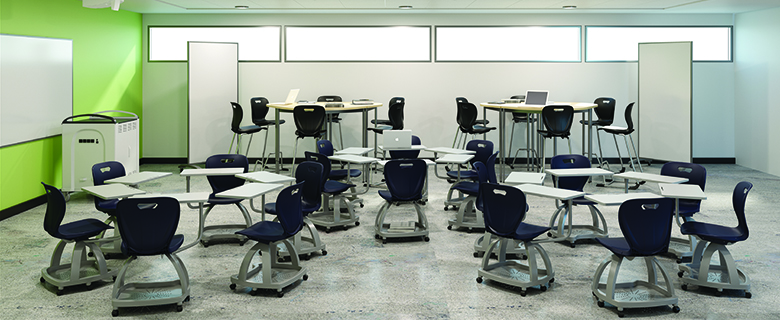What is a flexible learning space?
A flexible learning space is one that, through physical design, supports a variety of teaching methods and learning experiences. Unlike a traditional classroom, a flexible learning space can support both teacher-directed learning and collaborative, student-directed learning.
The hallmark of a flexible learning space is adaptable furniture and equipment that students can rearrange and use on a daily basis to best suit their learning needs. You'll often see mobile or adjustable collaborative desks and chairs, soft seating, flexible shelving or storage, and decentralized technology (such as laptops, tablets, interactive whiteboards or mobile whiteboards) in a flexible classroom. The teacher may even forgo a large, stationary desk upfront in favor of a small, moveable workstation - this makes him or her instantly accessible to students and leaves extra space for rearranging furniture.
It is not uncommon to see students standing, lying down, rocking or lounging in alternative seating - all while hard at work - in a flexible classroom. For example: One student may choose to work alone on a couch, while another may choose to work at an activity table with peers. Another may prefer to learn at a stand-up desk. How and where students choose to work often boils down to the day's learning activity and each person's comfort level.
Where did flexible learning spaces come from?
Flexible learning spaces evolved from traditional, lecture-based classrooms as researchers and practitioners began to explore the effects of physical space on students' academic performance and well-being in the late 20th century.
By the early 2000s, new learning technologies such as laptops, tablets and interactive boards became more affordable and began to trickle into schools. This quickly gave way to more tech-friendly and mobile furniture from suppliers, such as tablet arm chairs, tables with grommets and soft seating with outlets and USB ports. These advancements made it easy for educators to redesign their classrooms into more flexible, student-centered spaces, and the strategy quickly became popular in K-12 classrooms across the country.
What are its benefits to students?
Students benefit from a range of learning methods and experiences. A flexible learning space supports just that - it empowers students to explore different approaches to understanding topics and working through curriculum via adaptable and, perhaps most importantly, comfortable design.
Students feel a greater sense of responsibility for themselves and their academic success when given the chance to exercise power over how and where they learn within a classroom. Ideally, this boosts academic performance and student engagement, motivation, creativity and cooperation.
Rearranging a classroom's furniture or allowing students to be mobile learners has immediate, short-term physical benefits as well. It burns off excess energy, improves metabolism and increases blood flow to the brain (which in turn boosts mental cognition, concentration and overall behavior).
"Flexible Classrooms: Providing the Learning Environments That Kids Need." Edutopia. 4 Aug. 2015. Web. https://www.edutopia.org/practice/flexible-classrooms-providing-learning-environment-kids-need
"What are Flexible Learning Spaces?" St Stephen's School. 24 Aug. 2015. Web. https://www.ststephens.wa.edu.au/news-and-events/403-what-are-flexible-learning-spaces.html
Mahar, M. T., Murphy, S. K., Rowe, D. A., Golden, J., Shields, A. T., & Raedeke, T. D. "Effects of a Classroom-Based Program on Physical Activity an On-Task Behavior." Medicine and Science in sports and exercise. Vol. 38. 2006. Pp. 2086-2094. Web. http://nycphysicaleducation.com/wp-content/uploads/2013/03/Effects-of-a-Classroom-Based-Program-on-Physical-Activity-and-On-Task-Behavior.pdf
Neill, Stern. Etheridge, Rebecca. "Flexible Learning Spaces: The Integration of Pedagogy, Physical Design, and Instructional Technology." Marketing Education Review. Vol. 18. 2008. Pp. 47-53. Digital Commons @ Cal Poly. Web.
http://digitalcommons.calpoly.edu/cgi/viewcontent.cgi?article=1022&context=mkt_fac



